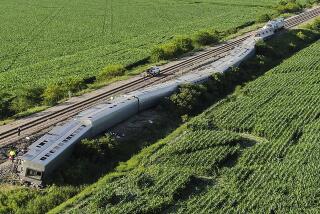Clinton Requests Funds for Earthquake Repairs : Aid: President asks Congress to OK $225 million, mainly for abandoned housing in Valley, Santa Monica.
Responding to a shortage of money for restoring quake-damaged housing, President Clinton asked the U.S. Congress on Tuesday to free up $225 million for the cities of Los Angeles and Santa Monica to issue as repair loans, particularly to those vacant, crime-infested enclaves known as “ghost towns.”
The funding, which was leftover aid from highway and school repair programs, would provide zero-interest loans to hundreds of owners of wrecked apartment buildings and condominiums who find they are unable to get loans through banks or other federal aid programs.
Los Angeles city housing officials lauded the announcement, saying it will nearly make up for a shortfall in the money needed to repair the more than 50,000 apartments, condos and single-family houses that were severely damaged in the Jan. 17 quake.
Speaking to Los Angeles Mayor Richard Riordan and Santa Monica Mayor Judy Abdo by telephone from Washington, Clinton called the money a “down payment on our partnership with the cities to solve this ghost town problem.”
“This goes beyond a typical federal disaster response, and it’s possible because we have been able to reallocate some other disaster funds,” he told the mayors and Housing Secretary Henry Cisneros and U.S. Sen. Diane Feinstein, who were also on the line from Washington.
If approved by Congress, as expected, Los Angeles housing officials will get $200 million of the total, while Santa Monica--which lost 5% of its housing stock in the disaster--will receive the $25 million balance, most of which it will also reserve for multiunit buildings.
The money is the latest of $11.9 billion in federal quake relief set aside by Clinton and Congress for quake victims in Southern California, a total that surpasses federal aid to all other recent disasters combined.
The President took advantage of the telephone conference call--and the media attention it had attracted--to mention a glowing report on federal assistance efforts during the first six months after the 6.8-magnitude quake.
“At every opportunity, federal agencies responded with speed, flexibility and creativity to meet the needs of earthquake victims,” according to the report, drafted by the federal Office of Management and Budget.
Riordan said he requested the housing loans from Clinton last week after learning that an estimated $400-million surplus in federal funds set aside for repairing quake damage to freeways and schools was available for other uses.
The mayor said the money is to be funneled to multiunit housing repair loans because that was where city housing officials had identified a large gap between need and funds.
“This will give us the flexibility to use the money where it is needed,” Riordan told Clinton.
Money previously allocated by the Federal Emergency Management Agency, the Small Business Administration and private insurance companies is expected to finance repairs of about 30,000 of the 50,000 severely damaged dwelling units in Los Angeles.
City housing officials already had secured $110 million in funding from other federal and local sources, enough to repair another 5,000 units. But that left the owners of the remaining 15,000 or so units without any help, or hope.
The money Clinton requested Tuesday is expected to repair most of those remaining units, said Gary Squier, general manager of Los Angeles’ city housing department.
“For the most part, these resources will take care of the bulk of the (remaining) damage,” he said.
Particularly troubling for those housing officials trying to restore the city’s damaged housing stock was the evolution of the ghost towns, clusters of vacant, damaged buildings that became infested with vagrants, scavengers, drug dealers, gang members and prostitutes.
Neighbors and city officials feared that the crime in those buildings would spread to nearby neighborhoods, and in some cases it quickly did.
The city has launched an aggressive attack plan against ghost towns that includes police sweeps followed by crews boarding up and fencing off vacant buildings. In the latest salvo, the city has hired round-the-clock security guards to keep trespassers out of the 12 ghost towns identified in the San Fernando Valley, Hollywood and the Mid-City area.
The bulk of the money requested Tuesday will be available to owners within the ghost towns, city officials said.
After the phone conference with Clinton, Councilman Richard Alarcon, whose northeast Valley district includes two ghost towns, said that the money “could not have come at a better time.”
“This money, if approved by Congress, will make it possible for the city to deal with one of our biggest problems--the ghost town buildings--which still represent a hazard to the community.”
Another important aspect of the funding request is that the owners of condominium units, which received an estimated $107-million damage in the quake, will have greater access to federal funds.
Federal housing regulations make it difficult for condo owners to qualify for federal loan programs, and “they fell through the cracks,” according to an aide for Rep. Howard L. Berman (D-Panorama City), who brought the problem to the attention of the Office of Management and Budget.
Squier said the money will be loaned out on a first-come, first-served basis. But because condominium financing is complicated by the presence of condo associations, he said an as-yet undetermined portion of the funding will be set aside just for condo repairs.
Apartment and condominium owners in Los Angeles can begin to apply for the loans immediately from the city’s housing department by calling (800) 994-4444. The loans will be limited to $35,000 per unit, and the federal funding rules require that 20% of the repaired units be set aside for affordable housing.
Times staff writer James Bornemeier in Washington also contributed to this story.
More to Read
Start your day right
Sign up for Essential California for news, features and recommendations from the L.A. Times and beyond in your inbox six days a week.
You may occasionally receive promotional content from the Los Angeles Times.







